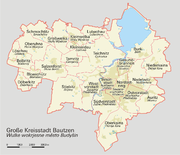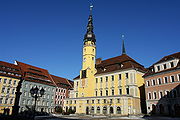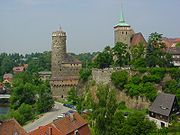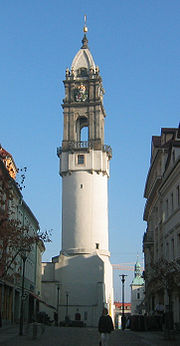
Bautzen
Encyclopedia
Bautzen (ˈbaʊtsən; Upper Sorbian: Budyšin ˈbudɨʃin; Lower Sorbian: Budyšyn ˈbudɨʃɨn, ) is a hill-top town in eastern Saxony, Germany
, and administrative centre of the eponymous district
. It is located on the Spree
River. As of 2008, its population is 41,161. Asteroid
11580 Bautzen
is named in honor of the city.
Bautzen is often regarded as the unofficial, but historical capital of Upper Lusatia
, and it is the most important cultural centre of the Sorbs
, a Slavic
people.
between the Lusatian highland
and the lowlands in the north, amidst the region of Upper Lusatia
. To the north stretches the Bautzen Reservoir
, which was flooded in 1974. This is the former location of the villages of Malsitz (Małšecy) and Nimschütz (Hněwsecy).
, Großdubrau
and Malschwitz
in the North, Kubschütz
in the East, Großpostwitz
, Obergurig
and Doberschau-Gaußig
in the South, as well as Göda
in the West. All of these belong to the Bautzen district
.



.
The first written evidence of the existence of the city was in 1002. In 1018 the Peace of Bautzen was signed between the German king Henry II
and the Polish prince Boleslaus I. The Treaty left Bautzen (Budziszyn in modern Polish) under Polish rule. In 1033 the city passed to the Holy Roman Empire
, in 1319 to Bohemia
and in 1635 to Saxony
. During the Middle Ages
it was a member of the Six Cities' Alliance of the Upper Lusatian cities of Görlitz
, Zittau
, Löbau
, Kamenz
, Lauban and Bautzen.
It was the site of one of the battlefields of the Napoleonic War Battle of Bautzen
in 1813.
During World War II
and the Nazi era
, there was a subcamp of the Groß-Rosen concentration camp in Bautzen. Ernst Thälmann
was imprisoned there before being deported to Buchenwald. Between 21 April and 30 April 1945, the Battle of Bautzen
was fought.
Furthermore Bautzen was infamous throughout the German Democratic Republic for its penitentiaries. Bautzen I was used as an official prison, soon to be nicknamed Gelbes Elend ("Yellow Misery"), whereas the secret Bautzen II was used as a prison for prisoners of conscience. Bautzen I is still used as a prison, and Bautzen II has served as a memorial since 1993.
In 2002 the city commemorated its thousandth birthday.
with:
 Worms
Worms
, since 1990 Heidelberg
, since 1991 Dreux
, France
, since 1992 Jablonec nad Nisou
, Czech Republic
, since 1993 Jelenia Góra
, Poland
, since 1993
, with one of the oldest preserved waterworks in central Europe (built 1558).
Sites of interest include:
There are four museums including the Stadtmuseum Bautzen ("Bautzen city Museum") and the Sorbisches Museum ("Sorbian Museum", Sorbian: Serbski muzej).
Germany
Germany , officially the Federal Republic of Germany , is a federal parliamentary republic in Europe. The country consists of 16 states while the capital and largest city is Berlin. Germany covers an area of 357,021 km2 and has a largely temperate seasonal climate...
, and administrative centre of the eponymous district
Bautzen (district)
Bautzen is a district in the Free State of Saxony in Germany including the former districts of Bischofswerda and Kamenz. It is bounded by the Czech Republic, the district of Sächsische Schweiz-Osterzgebirge, the district-free city Dresden and the districts of Meißen and Görlitz...
. It is located on the Spree
Spree
The Spree is a river that flows through the Saxony, Brandenburg and Berlin states of Germany, and in the Ústí nad Labem region of the Czech Republic...
River. As of 2008, its population is 41,161. Asteroid
Asteroid
Asteroids are a class of small Solar System bodies in orbit around the Sun. They have also been called planetoids, especially the larger ones...
11580 Bautzen
11580 Bautzen
11580 Bautzen is a main-belt asteroid discovered on May 3, 1994 by Spacewatch at Kitt Peak. The Asteroid is named after the German city of Bautzen.- External links :*...
is named in honor of the city.
Bautzen is often regarded as the unofficial, but historical capital of Upper Lusatia
Lusatia
Lusatia is a historical region in Central Europe. It stretches from the Bóbr and Kwisa rivers in the east to the Elbe valley in the west, today located within the German states of Saxony and Brandenburg as well as in the Lower Silesian and Lubusz voivodeships of western Poland...
, and it is the most important cultural centre of the Sorbs
Sorbs
Sorbs are a Western Slavic people of Central Europe living predominantly in Lusatia, a region on the territory of Germany and Poland. In Germany they live in the states of Brandenburg and Saxony. They speak the Sorbian languages - closely related to Polish and Czech - officially recognized and...
, a Slavic
Slavic peoples
The Slavic people are an Indo-European panethnicity living in Eastern Europe, Southeast Europe, North Asia and Central Asia. The term Slavic represents a broad ethno-linguistic group of people, who speak languages belonging to the Slavic language family and share, to varying degrees, certain...
people.
Geographical situation
The town on the River Spree is situated about 50 kilometres east of DresdenDresden
Dresden is the capital city of the Free State of Saxony in Germany. It is situated in a valley on the River Elbe, near the Czech border. The Dresden conurbation is part of the Saxon Triangle metropolitan area....
between the Lusatian highland
Lausitzer Bergland
The Lusatian Highlands is a hilly and low mountainous region in Germany and the Czech Republic. A western extension of the Sudetes range, it is located on the border of the German state of Saxony with the Czech Bohemian region...
and the lowlands in the north, amidst the region of Upper Lusatia
Upper Lusatia
Upper Lusatia is a region a biggest part of which belongs to Saxony, a small eastern part belongs to Poland, the northern part to Brandenburg. In Saxony, Upper Lusatia comprises roughly the districts of Bautzen and Görlitz , in Brandenburg the southern part of district Oberspreewald-Lausitz...
. To the north stretches the Bautzen Reservoir
Bautzen Reservoir
The Bautzen Reservoir, is a reservoir on the River Spree in Germany. It is situated just north of the city of Bautzen in the state of Saxony....
, which was flooded in 1974. This is the former location of the villages of Malsitz (Małšecy) and Nimschütz (Hněwsecy).
Expansion of the urban area
The old part of Bautzen is located on the plateau above the Spree, whose top is marked by the Ortenburg castle. It is bordered by the city walls. The later-built more recent quarters in the east were enclosed by the city ramparts. After their removal, the city expanded further east and to the left bank of the river. However, there has only been a small urban area west of the Spree until today. In the 1970s, the development areas of "Gesundbrunnen" and "Allendeviertel" were erected. After 1990, several neighbouring villages were incorporated.Bordering municipalities
The city is bordered by RadiborRadibor
Radibor, in Sorbian Radwor, is a municipality in Saxony in Germany. It is situated in Upper Lusatia about 10 km north of Bautzen, which is also the main city of the District of Bautzen to which Radibor belongs....
, Großdubrau
Großdubrau
Großdubrau, in Sorbian Wulka Dubrawa, is a municipality in the east of Saxony, Germany. It belongs to the district of Bautzen and lies north of the eponymous city.- Villages :Several villages belong to the municipality:...
and Malschwitz
Malschwitz
Malschwitz, Sorbian Malešecy, is a municipality in the east of Saxony, Germany. It belongs to the district of Bautzen and lies 6 km northeast of the eponymous city.- Geography :The municipality is situated in the Upper Lusatian flatland.- Villages :...
in the North, Kubschütz
Kubschütz
Kubschütz is a municipality in the district of Bautzen, in Saxony, Germany....
in the East, Großpostwitz
Großpostwitz
Großpostwitz is a municipality in the east of Saxony, Germany. It belongs to the district of Bautzen and lies south of the eponymous city.- Geography :...
, Obergurig
Obergurig
Obergurig is a municipality in the district of Bautzen, in Saxony, Germany....
and Doberschau-Gaußig
Doberschau-Gaußig
Doberschau-Gaußig is a municipality in the east of Saxony, Germany. It belongs to the district of Bautzen and lies southwest of the eponymous city.- Geography :...
in the South, as well as Göda
Göda
Göda, in Sorbian Hodźij, is a municipality in the east of Saxony, Germany. It belongs to the district of Bautzen and lies west of the eponymous city.- Villages :Several villages belong to the municipality:...
in the West. All of these belong to the Bautzen district
Bautzen (district)
Bautzen is a district in the Free State of Saxony in Germany including the former districts of Bischofswerda and Kamenz. It is bounded by the Czech Republic, the district of Sächsische Schweiz-Osterzgebirge, the district-free city Dresden and the districts of Meißen and Görlitz...
.

Subdivisions
The 15 city districts are (inhabitants as of January 1, 2009):- Innenstadt (Nutřkowne město - "City centre"), 5'278 inh.
- Südvorstadt (Južne Předměsto - "Southern outskirts"), 1'738 inh.
- Westvorstadt (Zapadne Předměsto - "Western outskirts"), 3'505 inh.
- Gesundbrunnen (Strowotna studnja), 8'178 inh.
- Nordostring (Sewjerowuchodny Wobkruh - "North-eastern ring"), 10'727 inh.
- Ostvorstadt (Wuchodne Předměsto - "Eastern outskirts"), 6'360 inh.
- Teichnitz (Wuchodne Předměsto), 377 inh.
- Nadelwitz (Nadźankecy), 268 inh.
- Burk (Bórk), 325 inh.
- Oberkaina (Hornja Kina), 832 inh.
- Niederkaina (Delnja Kina), 522 inh.
- Stiebitz (Sćijecy), 510 inh.
- Kleinwelka (Mały Wjelkow), 1'314 inh.
- Salzenforst-Bolbritz (Słona Boršć-Bolborcy), 839 inh.
- Auritz (Wuricy), 458 inh.


History
In the 3rd century AD an eastern Germanic settlement existed here, but excavations have proved that the region was already inhabited as early as the late Stone AgeStone Age
The Stone Age is a broad prehistoric period, lasting about 2.5 million years , during which humans and their predecessor species in the genus Homo, as well as the earlier partly contemporary genera Australopithecus and Paranthropus, widely used exclusively stone as their hard material in the...
.
The first written evidence of the existence of the city was in 1002. In 1018 the Peace of Bautzen was signed between the German king Henry II
Henry II, Holy Roman Emperor
Henry II , also referred to as Saint Henry, Obl.S.B., was the fifth and last Holy Roman Emperor of the Ottonian dynasty, from his coronation in Rome in 1014 until his death a decade later. He was crowned King of the Germans in 1002 and King of Italy in 1004...
and the Polish prince Boleslaus I. The Treaty left Bautzen (Budziszyn in modern Polish) under Polish rule. In 1033 the city passed to the Holy Roman Empire
Holy Roman Empire
The Holy Roman Empire was a realm that existed from 962 to 1806 in Central Europe.It was ruled by the Holy Roman Emperor. Its character changed during the Middle Ages and the Early Modern period, when the power of the emperor gradually weakened in favour of the princes...
, in 1319 to Bohemia
Bohemia
Bohemia is a historical region in central Europe, occupying the western two-thirds of the traditional Czech Lands. It is located in the contemporary Czech Republic with its capital in Prague...
and in 1635 to Saxony
Saxony
The Free State of Saxony is a landlocked state of Germany, contingent with Brandenburg, Saxony Anhalt, Thuringia, Bavaria, the Czech Republic and Poland. It is the tenth-largest German state in area, with of Germany's sixteen states....
. During the Middle Ages
Middle Ages
The Middle Ages is a periodization of European history from the 5th century to the 15th century. The Middle Ages follows the fall of the Western Roman Empire in 476 and precedes the Early Modern Era. It is the middle period of a three-period division of Western history: Classic, Medieval and Modern...
it was a member of the Six Cities' Alliance of the Upper Lusatian cities of Görlitz
Görlitz
Görlitz is a town in Germany. It is the easternmost town in the country, located on the Lusatian Neisse River in the Bundesland of Saxony. It is opposite the Polish town of Zgorzelec, which was a part of Görlitz until 1945. Historically, Görlitz was in the region of Upper Lusatia...
, Zittau
Zittau
Zittau is a city in the south east of the Free State of Saxony, Germany, close to the border tripoint of Germany, Poland, and the Czech Republic. , there are 28,638 people in the city. It is part of the Görlitz district....
, Löbau
Lobau
The Lobau is a Vienna floodplain on the northern side of the Danube and partly in Großenzersdorf, Lower Austria. It has been part of the Danube-Auen National Park since 1996 and has been a protected area since 1978. It is used as a recreational area and is known as a site of nudism. There is...
, Kamenz
Kamenz
Kamenz is a Lusatian town in eastern Saxony, Germany, with a population of 18,243, and is part of the Bautzen district. The town is located about northeast of Dresden and about northwest of Bautzen....
, Lauban and Bautzen.
It was the site of one of the battlefields of the Napoleonic War Battle of Bautzen
Battle of Bautzen
In the Battle of Bautzen a combined Russian/Prussian army was pushed back by Napoleon, but escaped destruction, some sources claim, because Michel Ney failed to block their retreat...
in 1813.
During World War II
World War II
World War II, or the Second World War , was a global conflict lasting from 1939 to 1945, involving most of the world's nations—including all of the great powers—eventually forming two opposing military alliances: the Allies and the Axis...
and the Nazi era
Nazi Germany
Nazi Germany , also known as the Third Reich , but officially called German Reich from 1933 to 1943 and Greater German Reich from 26 June 1943 onward, is the name commonly used to refer to the state of Germany from 1933 to 1945, when it was a totalitarian dictatorship ruled by...
, there was a subcamp of the Groß-Rosen concentration camp in Bautzen. Ernst Thälmann
Ernst Thälmann
Ernst Thälmann was the leader of the Communist Party of Germany during much of the Weimar Republic. He was arrested by the Gestapo in 1933 and held in solitary confinement for eleven years, before being shot in Buchenwald on Adolf Hitler's orders in 1944...
was imprisoned there before being deported to Buchenwald. Between 21 April and 30 April 1945, the Battle of Bautzen
Battle of Bautzen (1945)
The Battle of Bautzen was one of the last battles of the Eastern Front in World War II. It was fought on the extreme southern flank of the Spremberg–Torgau Offensive, seeing days of pitched street fighting between forces of the 2nd Polish Army and elements of the Soviet's 52nd Army and 5th Guards...
was fought.
Furthermore Bautzen was infamous throughout the German Democratic Republic for its penitentiaries. Bautzen I was used as an official prison, soon to be nicknamed Gelbes Elend ("Yellow Misery"), whereas the secret Bautzen II was used as a prison for prisoners of conscience. Bautzen I is still used as a prison, and Bautzen II has served as a memorial since 1993.
In 2002 the city commemorated its thousandth birthday.
International relations
Bautzen is twinnedTown twinning
Twin towns and sister cities are two of many terms used to describe the cooperative agreements between towns, cities, and even counties in geographically and politically distinct areas to promote cultural and commercial ties.- Terminology :...
with:

Worms, Germany
Worms is a city in Rhineland-Palatinate, Germany, on the Rhine River. At the end of 2004, it had 85,829 inhabitants.Established by the Celts, who called it Borbetomagus, Worms today remains embattled with the cities Trier and Cologne over the title of "Oldest City in Germany." Worms is the only...
, since 1990 Heidelberg
Heidelberg
-Early history:Between 600,000 and 200,000 years ago, "Heidelberg Man" died at nearby Mauer. His jaw bone was discovered in 1907; with scientific dating, his remains were determined to be the earliest evidence of human life in Europe. In the 5th century BC, a Celtic fortress of refuge and place of...
, since 1991 Dreux
Dreux
Dreux is a commune in the Eure-et-Loir department in northern France.-History:Dreux was known in ancient times as Durocassium, the capital of the Durocasses Celtic tribe. Despite the legend, its name was not related with Druids. The Romans established here a fortified camp known as Castrum...
, France
France
The French Republic , The French Republic , The French Republic , (commonly known as France , is a unitary semi-presidential republic in Western Europe with several overseas territories and islands located on other continents and in the Indian, Pacific, and Atlantic oceans. Metropolitan France...
, since 1992 Jablonec nad Nisou
Jablonec nad Nisou
Jablonec nad Nisou is a town in northern Bohemia, the second largest town of the Liberec Region. It is known as a mountain resort in the Jizera Mountains, an education centre, and a centre of world-production of glass and jewellery...
, Czech Republic
Czech Republic
The Czech Republic is a landlocked country in Central Europe. The country is bordered by Poland to the northeast, Slovakia to the east, Austria to the south, and Germany to the west and northwest....
, since 1993 Jelenia Góra
Jelenia Góra
----Jelenia Góra is a city in Lower Silesia, south-western Poland. The name of the city means "deer mountain" in Polish, Czech and German. It is close to the Krkonoše mountain range running along the Polish-Czech border – ski resorts such as Karpacz and Szklarska Poręba can be found...
, Poland
Poland
Poland , officially the Republic of Poland , is a country in Central Europe bordered by Germany to the west; the Czech Republic and Slovakia to the south; Ukraine, Belarus and Lithuania to the east; and the Baltic Sea and Kaliningrad Oblast, a Russian exclave, to the north...
, since 1993
Main sights
Bautzen has a very compact and well preserved medieval town centre with numerous churches and towers and a city wall on the steep embankment to the river SpreeSpree
The Spree is a river that flows through the Saxony, Brandenburg and Berlin states of Germany, and in the Ústí nad Labem region of the Czech Republic...
, with one of the oldest preserved waterworks in central Europe (built 1558).
Sites of interest include:
- The Reichenturm, one of the steepest leaning and still passable towers north of the Alps
- Ortenburg Castle
- The Old Waterworks, an architectural monument and museum
- Saint Peter's Cathedral, Eastern Germany's only historic interdenominationalSimultaneumA shared church, or Simultankirche, Simultaneum or, more fully, simultaneum mixtum, a term first coined in 16th century Germany, is a church in which public worship is conducted by adherents of two or more religious groups. Such churches became common in Europe in the wake of the Reformation...
church edifice - Hexenhaus (Witch's House), oldest preserved residential building (built in 1604)
There are four museums including the Stadtmuseum Bautzen ("Bautzen city Museum") and the Sorbisches Museum ("Sorbian Museum", Sorbian: Serbski muzej).
People
- Rudolf BuchheimRudolf BuchheimRudolf Buchheim was a German pharmacologist who was born in Bautzen. In 1845 he earned his doctorate from the University of Leipzig and soon after became a professor at the University of Dorpat. While at Dorpat he created the first pharmacological institute at that school...
- Hermann Lotze
- Caspar PeucerCaspar PeucerCaspar Peucer was a German reformer, physician, and scholar.-Biography:Born in Bautzen, Peucer studied mathematics, astronomy, and medicine at the University of Wittenberg from 1540...
- SilbermondSilbermondSilbermond is a German rock band from Bautzen, Saxony. The band consists of Stefanie Kloß, Andreas Nowak, Johannes and Thomas Stolle.-Biography:...
- Hans UngerHans UngerHans Unger was a German painter who was, during his lifetime, a highly respected Art Nouveau artist. His popularity did not survive the change in the artistic climate in Germany after World War I, however, and after his death he was soon forgotten...

